HI6008 Business Research: Social Networking in Business Networks
VerifiedAdded on 2023/04/03
|7
|1417
|342
Literature Review
AI Summary
This literature review explores the importance and adverse effects of social media on business networks, examining its role in creating relationships between people through online platforms like Facebook and LinkedIn. It discusses how social networking can improve communication with customers, enhance a company's reputation, and engage employees using principles like reciprocity, exchange, and similarity. However, it also highlights potential negative impacts such as damage to company reputation due to inappropriate posts, confidentiality risks, and reduced employee productivity. The review further analyzes the cultural impact of social media on business, considering factors like uncertainty avoidance and differing perceptions of time across cultures, referencing Hofstede's cultural dimensions. It concludes by emphasizing the importance of understanding both national and organizational cultures when implementing social media strategies in business.
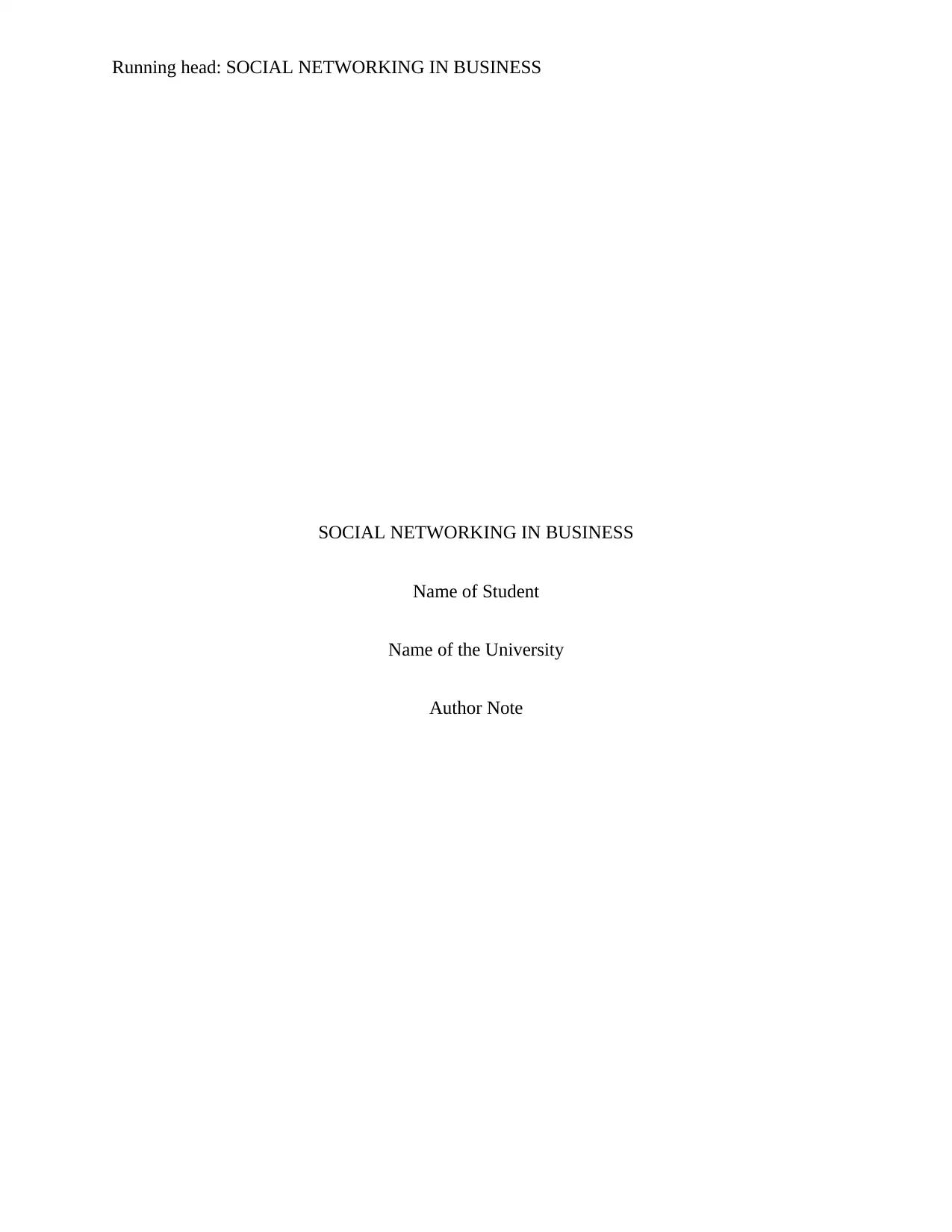
Running head: SOCIAL NETWORKING IN BUSINESS
SOCIAL NETWORKING IN BUSINESS
Name of Student
Name of the University
Author Note
SOCIAL NETWORKING IN BUSINESS
Name of Student
Name of the University
Author Note
Paraphrase This Document
Need a fresh take? Get an instant paraphrase of this document with our AI Paraphraser
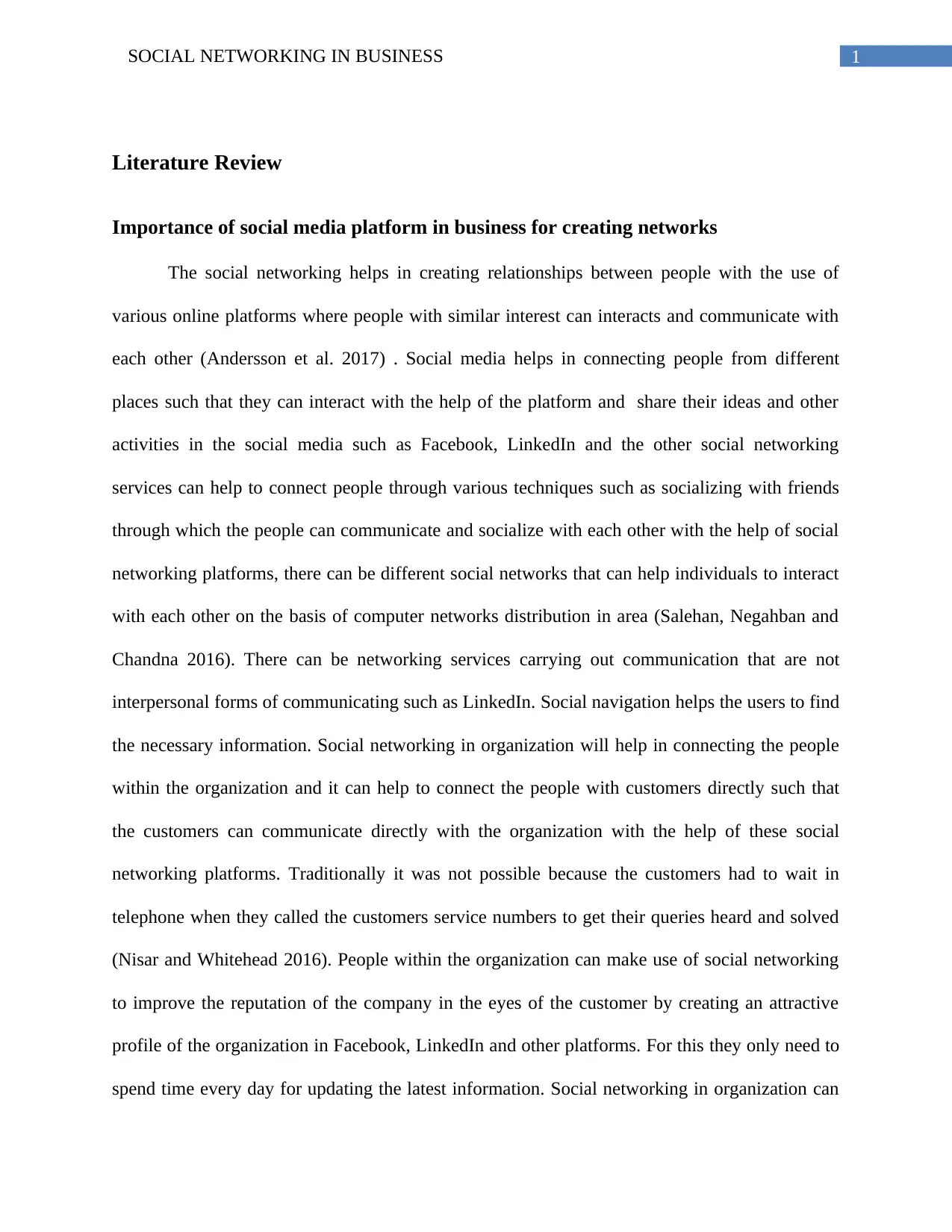
1SOCIAL NETWORKING IN BUSINESS
Literature Review
Importance of social media platform in business for creating networks
The social networking helps in creating relationships between people with the use of
various online platforms where people with similar interest can interacts and communicate with
each other (Andersson et al. 2017) . Social media helps in connecting people from different
places such that they can interact with the help of the platform and share their ideas and other
activities in the social media such as Facebook, LinkedIn and the other social networking
services can help to connect people through various techniques such as socializing with friends
through which the people can communicate and socialize with each other with the help of social
networking platforms, there can be different social networks that can help individuals to interact
with each other on the basis of computer networks distribution in area (Salehan, Negahban and
Chandna 2016). There can be networking services carrying out communication that are not
interpersonal forms of communicating such as LinkedIn. Social navigation helps the users to find
the necessary information. Social networking in organization will help in connecting the people
within the organization and it can help to connect the people with customers directly such that
the customers can communicate directly with the organization with the help of these social
networking platforms. Traditionally it was not possible because the customers had to wait in
telephone when they called the customers service numbers to get their queries heard and solved
(Nisar and Whitehead 2016). People within the organization can make use of social networking
to improve the reputation of the company in the eyes of the customer by creating an attractive
profile of the organization in Facebook, LinkedIn and other platforms. For this they only need to
spend time every day for updating the latest information. Social networking in organization can
Literature Review
Importance of social media platform in business for creating networks
The social networking helps in creating relationships between people with the use of
various online platforms where people with similar interest can interacts and communicate with
each other (Andersson et al. 2017) . Social media helps in connecting people from different
places such that they can interact with the help of the platform and share their ideas and other
activities in the social media such as Facebook, LinkedIn and the other social networking
services can help to connect people through various techniques such as socializing with friends
through which the people can communicate and socialize with each other with the help of social
networking platforms, there can be different social networks that can help individuals to interact
with each other on the basis of computer networks distribution in area (Salehan, Negahban and
Chandna 2016). There can be networking services carrying out communication that are not
interpersonal forms of communicating such as LinkedIn. Social navigation helps the users to find
the necessary information. Social networking in organization will help in connecting the people
within the organization and it can help to connect the people with customers directly such that
the customers can communicate directly with the organization with the help of these social
networking platforms. Traditionally it was not possible because the customers had to wait in
telephone when they called the customers service numbers to get their queries heard and solved
(Nisar and Whitehead 2016). People within the organization can make use of social networking
to improve the reputation of the company in the eyes of the customer by creating an attractive
profile of the organization in Facebook, LinkedIn and other platforms. For this they only need to
spend time every day for updating the latest information. Social networking in organization can
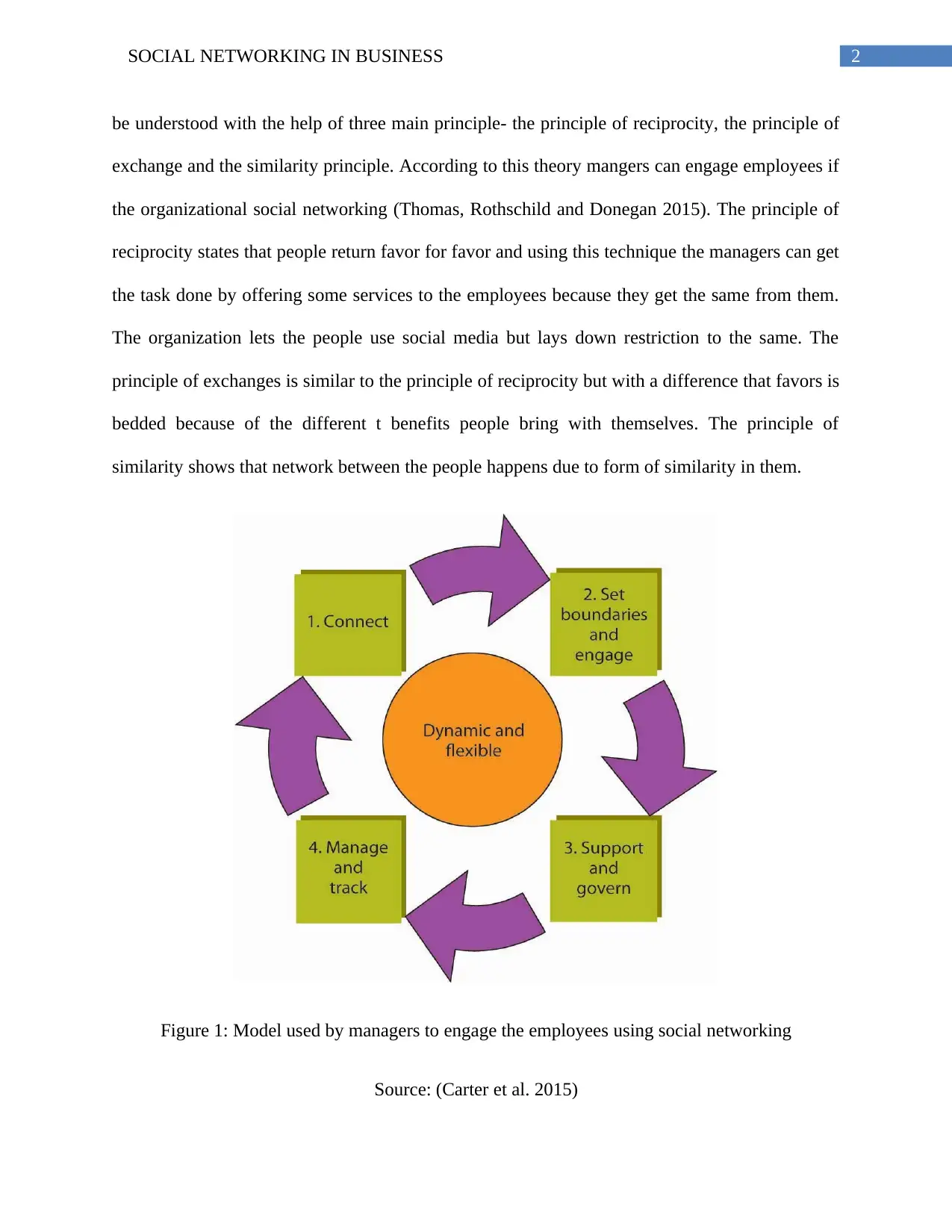
2SOCIAL NETWORKING IN BUSINESS
be understood with the help of three main principle- the principle of reciprocity, the principle of
exchange and the similarity principle. According to this theory mangers can engage employees if
the organizational social networking (Thomas, Rothschild and Donegan 2015). The principle of
reciprocity states that people return favor for favor and using this technique the managers can get
the task done by offering some services to the employees because they get the same from them.
The organization lets the people use social media but lays down restriction to the same. The
principle of exchanges is similar to the principle of reciprocity but with a difference that favors is
bedded because of the different t benefits people bring with themselves. The principle of
similarity shows that network between the people happens due to form of similarity in them.
Figure 1: Model used by managers to engage the employees using social networking
Source: (Carter et al. 2015)
be understood with the help of three main principle- the principle of reciprocity, the principle of
exchange and the similarity principle. According to this theory mangers can engage employees if
the organizational social networking (Thomas, Rothschild and Donegan 2015). The principle of
reciprocity states that people return favor for favor and using this technique the managers can get
the task done by offering some services to the employees because they get the same from them.
The organization lets the people use social media but lays down restriction to the same. The
principle of exchanges is similar to the principle of reciprocity but with a difference that favors is
bedded because of the different t benefits people bring with themselves. The principle of
similarity shows that network between the people happens due to form of similarity in them.
Figure 1: Model used by managers to engage the employees using social networking
Source: (Carter et al. 2015)
⊘ This is a preview!⊘
Do you want full access?
Subscribe today to unlock all pages.

Trusted by 1+ million students worldwide
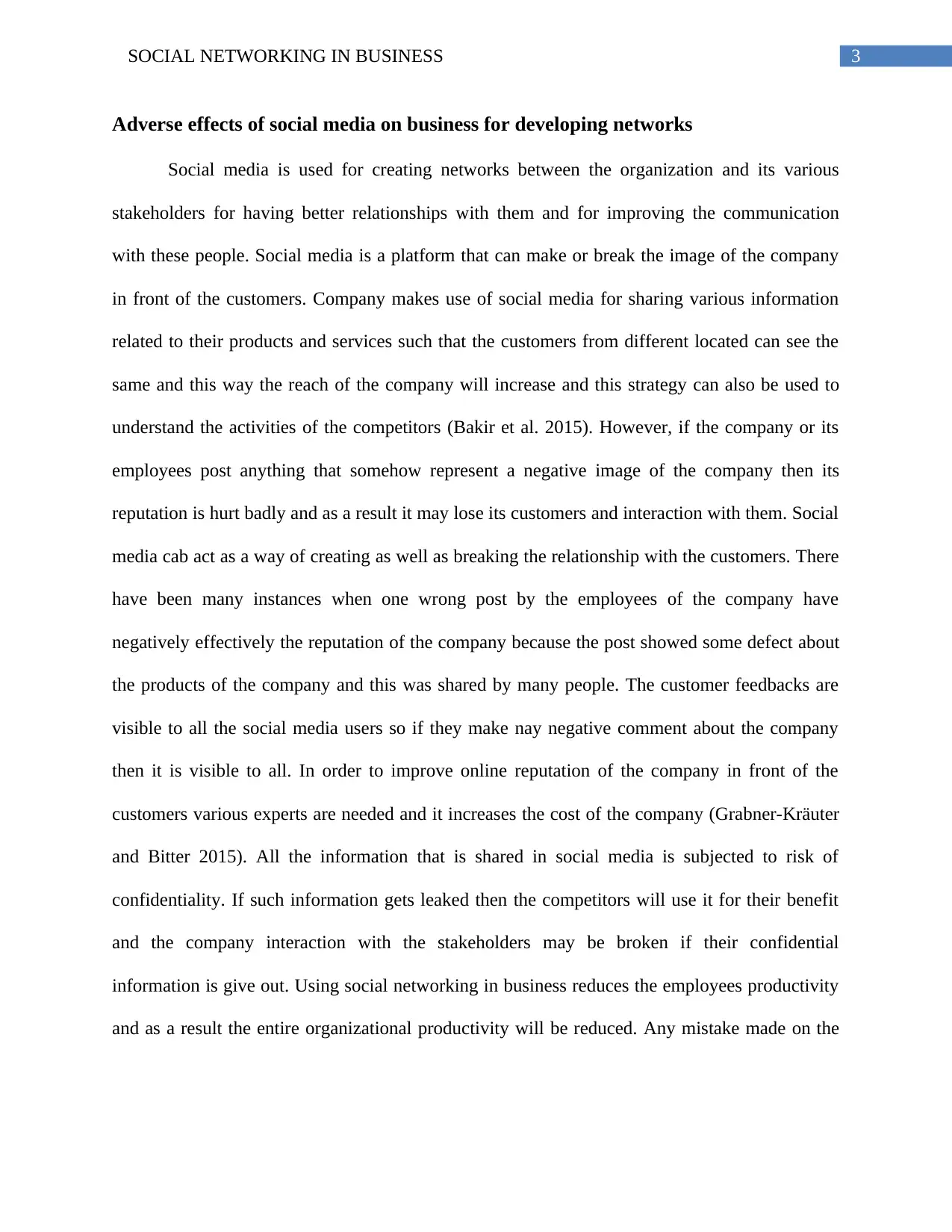
3SOCIAL NETWORKING IN BUSINESS
Adverse effects of social media on business for developing networks
Social media is used for creating networks between the organization and its various
stakeholders for having better relationships with them and for improving the communication
with these people. Social media is a platform that can make or break the image of the company
in front of the customers. Company makes use of social media for sharing various information
related to their products and services such that the customers from different located can see the
same and this way the reach of the company will increase and this strategy can also be used to
understand the activities of the competitors (Bakir et al. 2015). However, if the company or its
employees post anything that somehow represent a negative image of the company then its
reputation is hurt badly and as a result it may lose its customers and interaction with them. Social
media cab act as a way of creating as well as breaking the relationship with the customers. There
have been many instances when one wrong post by the employees of the company have
negatively effectively the reputation of the company because the post showed some defect about
the products of the company and this was shared by many people. The customer feedbacks are
visible to all the social media users so if they make nay negative comment about the company
then it is visible to all. In order to improve online reputation of the company in front of the
customers various experts are needed and it increases the cost of the company (Grabner-Kräuter
and Bitter 2015). All the information that is shared in social media is subjected to risk of
confidentiality. If such information gets leaked then the competitors will use it for their benefit
and the company interaction with the stakeholders may be broken if their confidential
information is give out. Using social networking in business reduces the employees productivity
and as a result the entire organizational productivity will be reduced. Any mistake made on the
Adverse effects of social media on business for developing networks
Social media is used for creating networks between the organization and its various
stakeholders for having better relationships with them and for improving the communication
with these people. Social media is a platform that can make or break the image of the company
in front of the customers. Company makes use of social media for sharing various information
related to their products and services such that the customers from different located can see the
same and this way the reach of the company will increase and this strategy can also be used to
understand the activities of the competitors (Bakir et al. 2015). However, if the company or its
employees post anything that somehow represent a negative image of the company then its
reputation is hurt badly and as a result it may lose its customers and interaction with them. Social
media cab act as a way of creating as well as breaking the relationship with the customers. There
have been many instances when one wrong post by the employees of the company have
negatively effectively the reputation of the company because the post showed some defect about
the products of the company and this was shared by many people. The customer feedbacks are
visible to all the social media users so if they make nay negative comment about the company
then it is visible to all. In order to improve online reputation of the company in front of the
customers various experts are needed and it increases the cost of the company (Grabner-Kräuter
and Bitter 2015). All the information that is shared in social media is subjected to risk of
confidentiality. If such information gets leaked then the competitors will use it for their benefit
and the company interaction with the stakeholders may be broken if their confidential
information is give out. Using social networking in business reduces the employees productivity
and as a result the entire organizational productivity will be reduced. Any mistake made on the
Paraphrase This Document
Need a fresh take? Get an instant paraphrase of this document with our AI Paraphraser
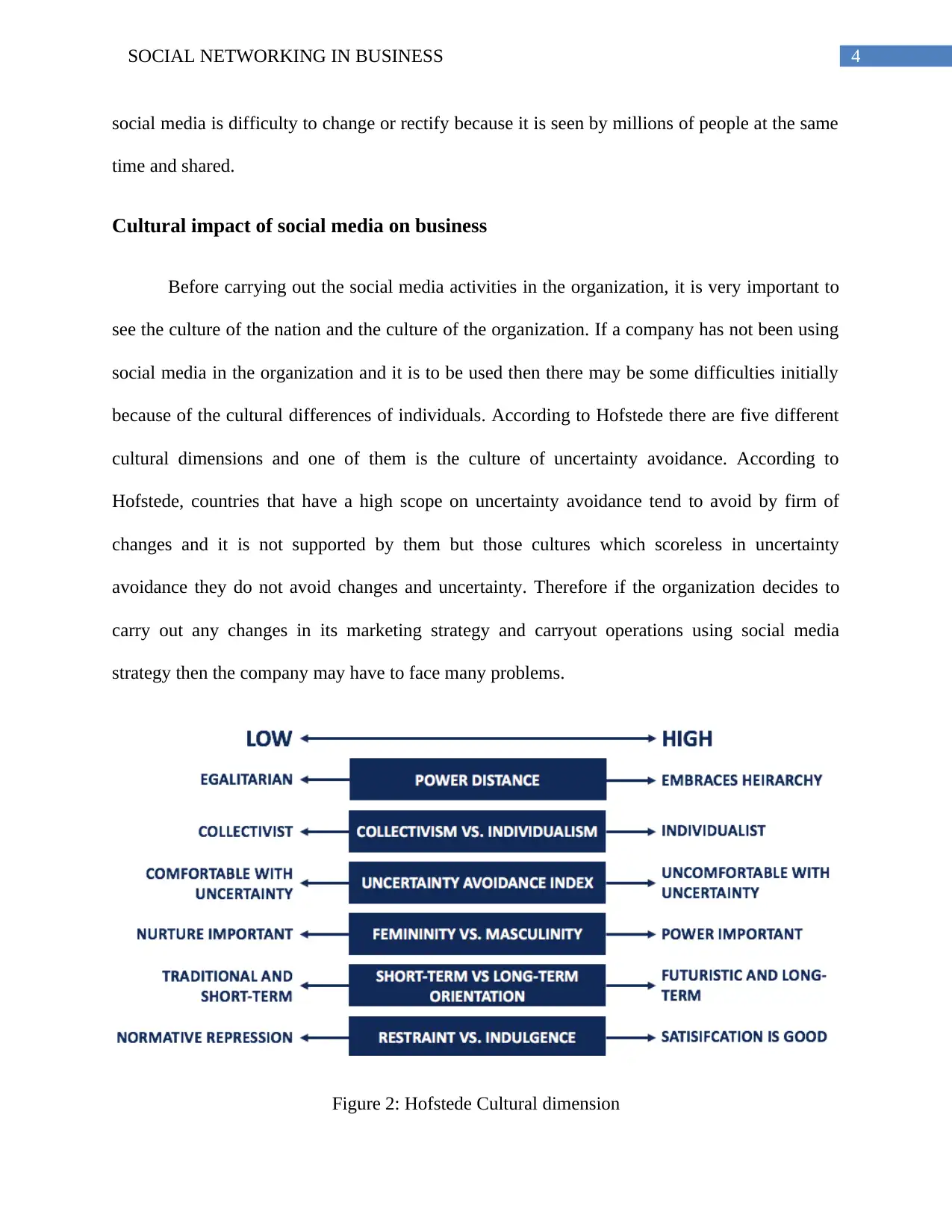
4SOCIAL NETWORKING IN BUSINESS
social media is difficulty to change or rectify because it is seen by millions of people at the same
time and shared.
Cultural impact of social media on business
Before carrying out the social media activities in the organization, it is very important to
see the culture of the nation and the culture of the organization. If a company has not been using
social media in the organization and it is to be used then there may be some difficulties initially
because of the cultural differences of individuals. According to Hofstede there are five different
cultural dimensions and one of them is the culture of uncertainty avoidance. According to
Hofstede, countries that have a high scope on uncertainty avoidance tend to avoid by firm of
changes and it is not supported by them but those cultures which scoreless in uncertainty
avoidance they do not avoid changes and uncertainty. Therefore if the organization decides to
carry out any changes in its marketing strategy and carryout operations using social media
strategy then the company may have to face many problems.
Figure 2: Hofstede Cultural dimension
social media is difficulty to change or rectify because it is seen by millions of people at the same
time and shared.
Cultural impact of social media on business
Before carrying out the social media activities in the organization, it is very important to
see the culture of the nation and the culture of the organization. If a company has not been using
social media in the organization and it is to be used then there may be some difficulties initially
because of the cultural differences of individuals. According to Hofstede there are five different
cultural dimensions and one of them is the culture of uncertainty avoidance. According to
Hofstede, countries that have a high scope on uncertainty avoidance tend to avoid by firm of
changes and it is not supported by them but those cultures which scoreless in uncertainty
avoidance they do not avoid changes and uncertainty. Therefore if the organization decides to
carry out any changes in its marketing strategy and carryout operations using social media
strategy then the company may have to face many problems.
Figure 2: Hofstede Cultural dimension
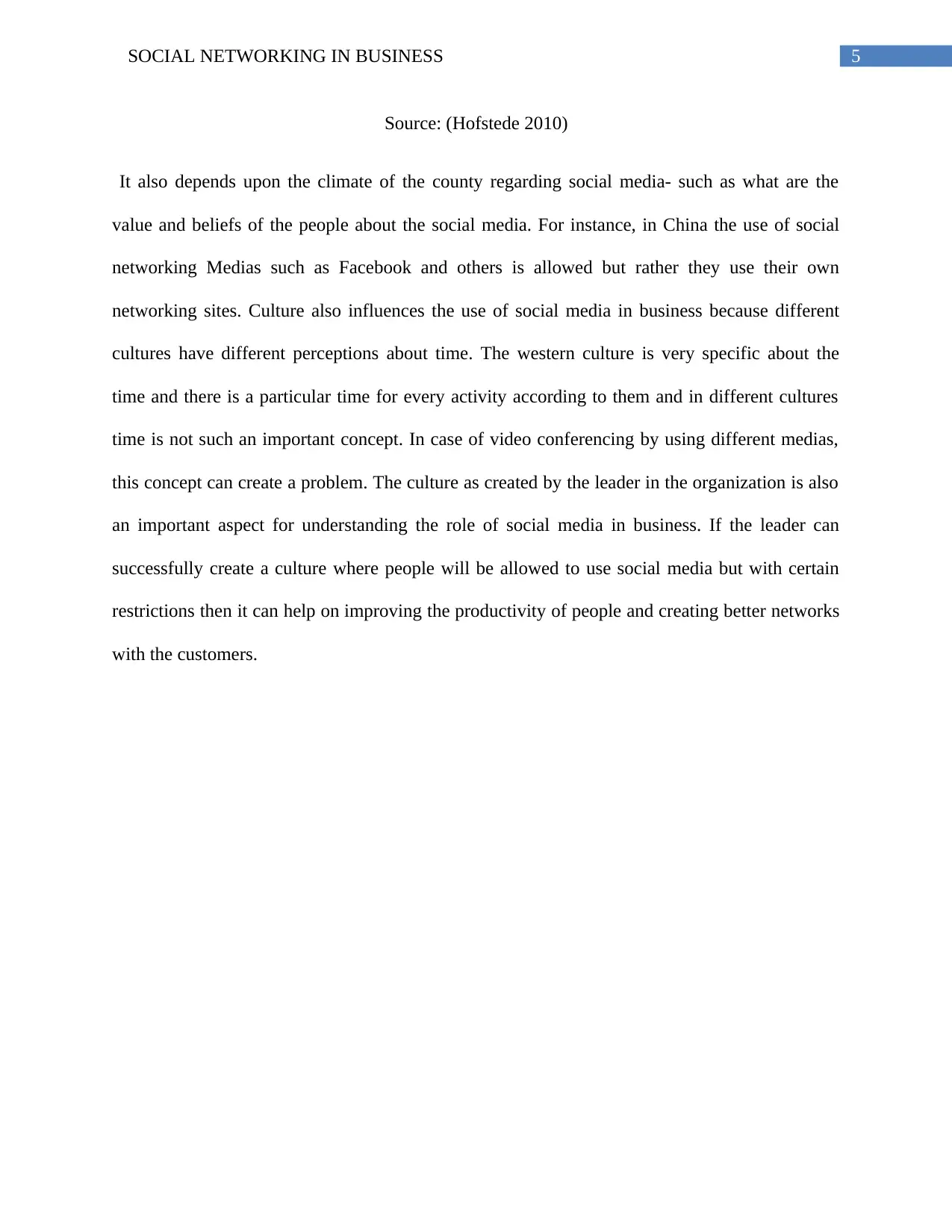
5SOCIAL NETWORKING IN BUSINESS
Source: (Hofstede 2010)
It also depends upon the climate of the county regarding social media- such as what are the
value and beliefs of the people about the social media. For instance, in China the use of social
networking Medias such as Facebook and others is allowed but rather they use their own
networking sites. Culture also influences the use of social media in business because different
cultures have different perceptions about time. The western culture is very specific about the
time and there is a particular time for every activity according to them and in different cultures
time is not such an important concept. In case of video conferencing by using different medias,
this concept can create a problem. The culture as created by the leader in the organization is also
an important aspect for understanding the role of social media in business. If the leader can
successfully create a culture where people will be allowed to use social media but with certain
restrictions then it can help on improving the productivity of people and creating better networks
with the customers.
Source: (Hofstede 2010)
It also depends upon the climate of the county regarding social media- such as what are the
value and beliefs of the people about the social media. For instance, in China the use of social
networking Medias such as Facebook and others is allowed but rather they use their own
networking sites. Culture also influences the use of social media in business because different
cultures have different perceptions about time. The western culture is very specific about the
time and there is a particular time for every activity according to them and in different cultures
time is not such an important concept. In case of video conferencing by using different medias,
this concept can create a problem. The culture as created by the leader in the organization is also
an important aspect for understanding the role of social media in business. If the leader can
successfully create a culture where people will be allowed to use social media but with certain
restrictions then it can help on improving the productivity of people and creating better networks
with the customers.
⊘ This is a preview!⊘
Do you want full access?
Subscribe today to unlock all pages.

Trusted by 1+ million students worldwide
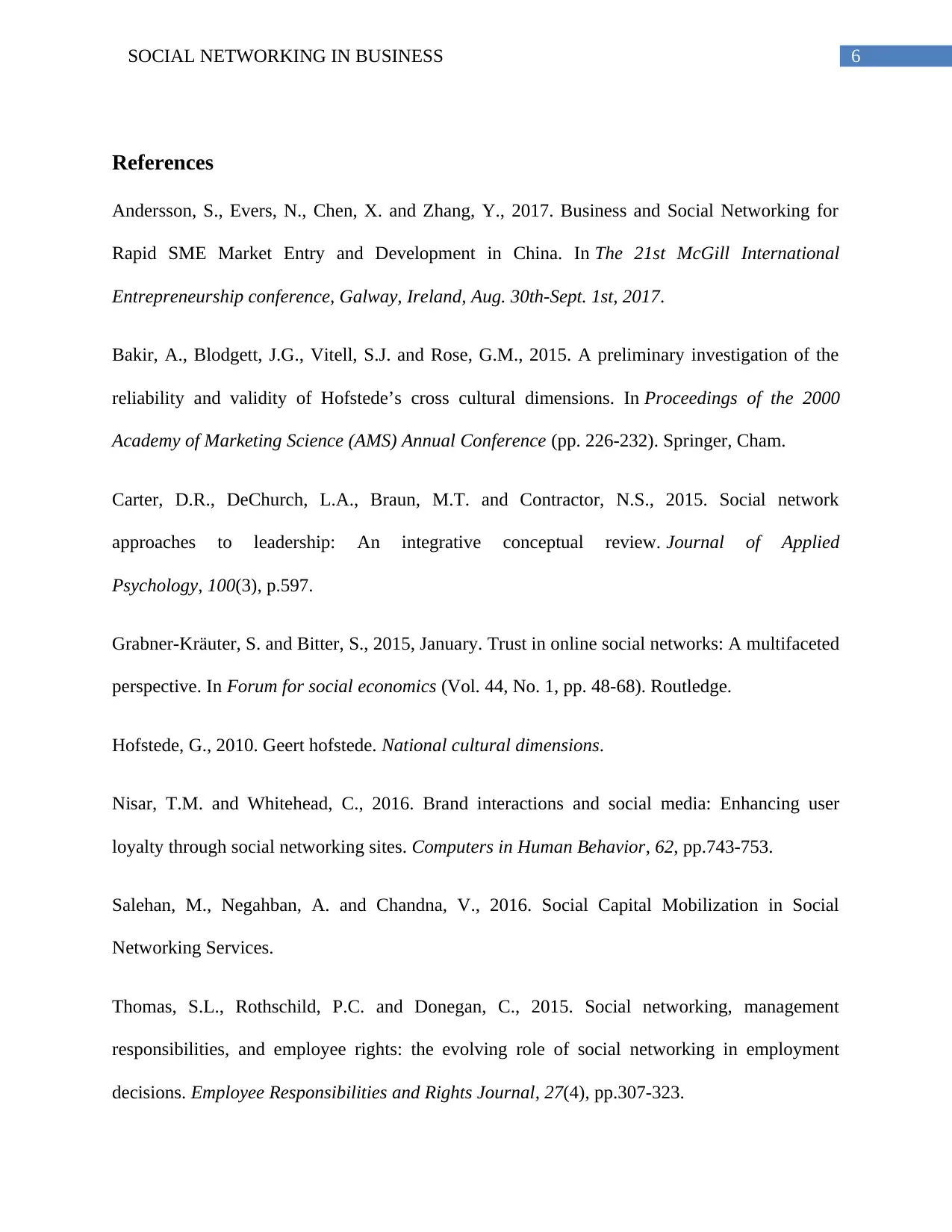
6SOCIAL NETWORKING IN BUSINESS
References
Andersson, S., Evers, N., Chen, X. and Zhang, Y., 2017. Business and Social Networking for
Rapid SME Market Entry and Development in China. In The 21st McGill International
Entrepreneurship conference, Galway, Ireland, Aug. 30th-Sept. 1st, 2017.
Bakir, A., Blodgett, J.G., Vitell, S.J. and Rose, G.M., 2015. A preliminary investigation of the
reliability and validity of Hofstede’s cross cultural dimensions. In Proceedings of the 2000
Academy of Marketing Science (AMS) Annual Conference (pp. 226-232). Springer, Cham.
Carter, D.R., DeChurch, L.A., Braun, M.T. and Contractor, N.S., 2015. Social network
approaches to leadership: An integrative conceptual review. Journal of Applied
Psychology, 100(3), p.597.
Grabner-Kräuter, S. and Bitter, S., 2015, January. Trust in online social networks: A multifaceted
perspective. In Forum for social economics (Vol. 44, No. 1, pp. 48-68). Routledge.
Hofstede, G., 2010. Geert hofstede. National cultural dimensions.
Nisar, T.M. and Whitehead, C., 2016. Brand interactions and social media: Enhancing user
loyalty through social networking sites. Computers in Human Behavior, 62, pp.743-753.
Salehan, M., Negahban, A. and Chandna, V., 2016. Social Capital Mobilization in Social
Networking Services.
Thomas, S.L., Rothschild, P.C. and Donegan, C., 2015. Social networking, management
responsibilities, and employee rights: the evolving role of social networking in employment
decisions. Employee Responsibilities and Rights Journal, 27(4), pp.307-323.
References
Andersson, S., Evers, N., Chen, X. and Zhang, Y., 2017. Business and Social Networking for
Rapid SME Market Entry and Development in China. In The 21st McGill International
Entrepreneurship conference, Galway, Ireland, Aug. 30th-Sept. 1st, 2017.
Bakir, A., Blodgett, J.G., Vitell, S.J. and Rose, G.M., 2015. A preliminary investigation of the
reliability and validity of Hofstede’s cross cultural dimensions. In Proceedings of the 2000
Academy of Marketing Science (AMS) Annual Conference (pp. 226-232). Springer, Cham.
Carter, D.R., DeChurch, L.A., Braun, M.T. and Contractor, N.S., 2015. Social network
approaches to leadership: An integrative conceptual review. Journal of Applied
Psychology, 100(3), p.597.
Grabner-Kräuter, S. and Bitter, S., 2015, January. Trust in online social networks: A multifaceted
perspective. In Forum for social economics (Vol. 44, No. 1, pp. 48-68). Routledge.
Hofstede, G., 2010. Geert hofstede. National cultural dimensions.
Nisar, T.M. and Whitehead, C., 2016. Brand interactions and social media: Enhancing user
loyalty through social networking sites. Computers in Human Behavior, 62, pp.743-753.
Salehan, M., Negahban, A. and Chandna, V., 2016. Social Capital Mobilization in Social
Networking Services.
Thomas, S.L., Rothschild, P.C. and Donegan, C., 2015. Social networking, management
responsibilities, and employee rights: the evolving role of social networking in employment
decisions. Employee Responsibilities and Rights Journal, 27(4), pp.307-323.
1 out of 7
Related Documents
Your All-in-One AI-Powered Toolkit for Academic Success.
+13062052269
info@desklib.com
Available 24*7 on WhatsApp / Email
![[object Object]](/_next/static/media/star-bottom.7253800d.svg)
Unlock your academic potential
Copyright © 2020–2025 A2Z Services. All Rights Reserved. Developed and managed by ZUCOL.




